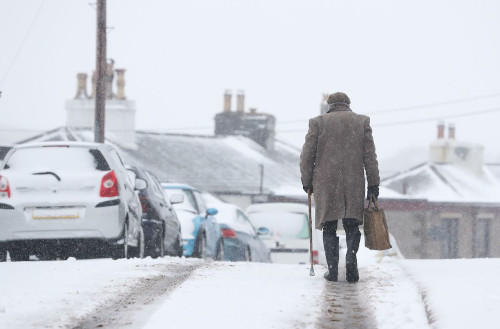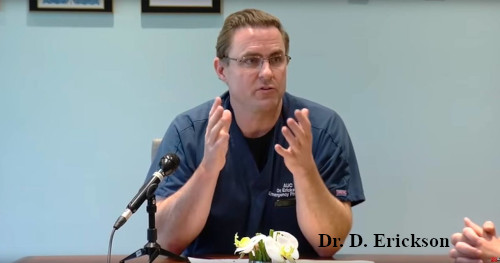Pandemic 2020: From Statistical Fraud to Controlled Society (1)
By Vincent Mathieu, PhD
(Canadian doctor of psychology
and group therapist)
The outbreak of Covid-19 which first occurred in China in the autumn of 2019 did not, at that time, seem to herald a crisis of such magnitude in the West. In Quebec, the new coronavirus (Sars-Cov-2) was referred to as a virus that was certainly contagious, but which did not threaten the health of Quebecers more than a flu. Various experts reported in the newspapers indicated that seasonal influenza caused more deaths than this new virus, and therefore Sars Cov-2 was less to fear than the influenza with which we have to deal cyclically.

In early March 2020, the narrative changed in a frightening way. Following the World Health Organization’s (WHO) announcement of a pandemic status, most Western countries responded by restricting air traffic and closing borders. This was followed by declarations of health emergencies that led to the seizure of power by the Public Health Directorates (PHDs). This last aspect is of prime importance, as the seizure of power brought most economic sectors and social life to a standstill.
During this period, it is important to realize that the reins of the state were given to the DSPs (Dr. Horacio Arruda in Quebec). In other words, the emergency health law, like martial law, deprived citizens of their rights and freedoms in order to protect them from a major crisis situation. It goes without saying that the implementation of these laws, which are opposed to democracy and civil law, should only be done in extreme emergency situations.
We were therefore told, on the basis of figures given by the WHO (3.4% mortality rate), that the situation was one of extreme urgency. The statistical curves based on these data predicted, for example, the deaths of approximately 60,000 Quebeckers and 2 million Americans if we did not proceed with containment measures. These figures are chilling and would have justified the health emergency measures taken by governments. The problem is that these predictions proved to be exaggerated. Indeed, several experts have questioned the credibility of WHO data on mortality rates based on two major issues:
– how many cases of coronavirus are there actually?
– how many people die directly from it?
First, the number of cases with the virus is underestimated. Data from China (1), Germany (2) and the United States (3) suggest that the number of cases infected with Covid-19 was, from the beginning of the pandemic, much higher than that reported by public health authorities. Based on these data, therefore, it is likely that the number of people infected with Sars-Cov-2 was already high in the “healthy population” when the first mortality rates and alarmist predictions were revealed to the population.
Since the various national CSPs, with WHO as a chaperone, calculated mortality rates based on the number of confirmed cases or on a lower number of cases than the actual number of cases (i.e. excluding many asymptomatic cases or people who develop mild forms of Covid-19 without ever being tested), it is clear that the mortality rate was inflated as a result. This is what Dr. Antony Fauci and colleagues said in an editorial note in the New England Journal of Medicine published on February 28, 2020:
“Assuming that the number of asymptomatic or mildly symptomatic cases is several times higher than the number of reported cases, the case-fatality rate can be considerably less than 1%. This suggests that the overall clinical consequences of COVID-19 may ultimately be closer to those of severe seasonal influenza (which has a case-fatality rate of about 0.1%) or pandemic influenza (similar to 1957 and 1968).”
According to Dr. John Ioannidis, a professor of medicine and researcher at Stanford University in California, the mortality rate of Covid-19 was from the outset greatly overestimated by the lack of effective screening. In an editorial video by journalist Fareed Zakaria posted on CNN’s website, he reports that Dr. Ioannidis believes that based on an effective screening method such as the one used on the Diamond Princess in the Italian town of Vo’ Euganeo, Iceland and Denmark, the estimated mortality rate of Covid-19 would be about the same as that of seasonal influenza.

For Dr. Ioannidis, any statistical model based on exponential case growth is highly vulnerable to estimation errors. If the denominator on which to count mortality rates is incorrectly established, the statistical model may come up with a rate that is erroneous by a multiplier of 10, 30, or even 50. In other words, the number of deaths would be 10 to 50 times lower than the statistical models predict. According to Dr. Ioannidis’ estimates, the case-fatality rate of Covid-19 would be 0.05% to 1%, much lower than the 3.4% initially proposed by WHO (4). According to the same estimates, the actual number of deaths related to Covid-19 in the United States could be in the range of 10,000 to 40,000. These figures are exactly within the range of influenza-related deaths in the United States in 2019 (5).
In Quebec, for example, we were told that there could have been as many as 60,000 deaths if there had been no containment. If we take a median multiplier compared to Dr. Ioannidis’ proposals, that is, a negative multiplier of 30, we would have a mortality rate of 2,000 people. That’s about the same number of deaths that occur during seasonal influenza episodes. For example, the number of deaths associated with influenza and pneumonia in Quebec in 2016, when there was no high peak mortality, was 1733 (6).
On May 5, 2020, the date of first publication of this article, the official number of deaths was close to 2,400 in Quebec, around 70,000 in the United States and around 250,000 worldwide. However, the method of calculating the number of deaths raises major questions. In an open letter written to German Chancellor Angela Merkel, Dr. Sucharit Bhakdi mentions (7):
“The mistake is made worldwide to report virus-related deaths as soon as it is established that the virus was present at the time of death – irrespective of other factors. This violates a basic principle of infectiology: a diagnosis can only be made when it is certain that an agent played a significant role in the illness or death.”
As Dr. Bhakdi points out, it is thus impossible to distinguish between deaths genuinely related to Covid-19 and deaths that occurred for other medical reasons in the accidental presence of the virus. In other words, no distinction is made between those who died because of the virus and those who died with the virus. We will see that this practice, probably under the orders of the WHO, has been widespread throughout the world.
In Quebec, we have heard Dr. Arruda mention the issue of epidemiological links several times. That is exactly the mistake Dr. Bhakdi is talking about. According to this way of calculating, even in cases of “Covid-19 deaths”, people are included who have symptoms similar to those of the disease, without testing to make sure. On April 16, 2020, Dr. Arruda stated in the daily press briefing of the Quebec government:
“There has been a change in the method of data entry and epidemiological analysis by public health of patients who have died within the last week. The choice we made was to report all patients, even patients who were not tested, but who have all the definitions to be patients who died from Covid-19.”

Another aberration in the way deaths are counted is that public health chooses to consider as “Covid-19 deaths” people who simply rubbed shoulders with other Covid-19 sufferers or deaths. In other words, if a woman in a long-term care facility died and occupied a room adjacent to a confirmed case of Covid-19, she was declared to have died of Covid-19. This is what Dr. Arruda said at the press briefing on April 14, 2020, following a question about non-routine screening:
“We’re not waiting for the coroner’s inquest, we’re counting these cases. We haven’t tested every case. It’s a case definition called epidemiologically linked cases. If there are cases in a long-term care facility, on the same floor, 1 or 2 cases confirmed in the laboratory, if in the next room you have a case, no other reasons for death as such, we are almost certain, to a large extent, that it is Covid-19”.
In the press briefing of 22 April 2020, Dr Arruda returned to this epidemiological analysis, describing it as “scrupulous” and “transparent”. Here is the hallucinating statement that followed a few seconds later:
“I’d like to remind you that every year, under normal circumstances, about 1,000 people a month die in long-term care facilities. And basically, it must be understood that the current deaths that we are counting associated with Covid-19, (they) would have occurred despite the situation”.
We are literally telling ourselves that the deaths that have been associated with Covid-19 for more than a month and which are sowing panic in the population would have occurred anyway. One journalist even made this schizophrenic comment: “Don’t you think that underestimates the number of deaths?” It is clear, using common sense (something that some journalists employed by the major media outlets no longer seem to have), that this method of calculation considerably overestimates the number of deaths linked to Covid-19.
Here is another example of this mystifying calculation. On his daily show, posted on the Journal de Montréal website on April 23, 2020, Mario Dumont received Dr. Vinh-Kim Nguyen, an emergency physician at the Jewish General Hospital in Montreal. Mr. Dumont was asking questions about how to account for deaths related to Covid-19, as it was questioned whether some of the deaths observed in long-term care facilities were related more to a lack of care than to Covid-19. The following is part of the exchange between Mr. Dumont and Dr. Nguyen (8):
“Dr. Nguyen: What we can do and what the French and other countries are already doing is that in a pandemic state, all deaths are above average. In other words, if today in Quebec we have an average of 58 deaths, and this year we have 82, we’re going to add 24, 24 more, we’re going to attribute (them) to the Covid. We’re not going to look any further, we’re not going to look in the (death) certificates.
Mr. Dumont: We are going to assume that the surplus of deaths is related to the pandemic that is in place.
Dr. Nguyen: Linked directly or indirectly to the pandemic”.
It is difficult to understand why journalists accepted with enthusiasm this inflationary calculation method without questioning it. The method whereby people are reported to have died from Covid-19 because of epidemiological links or simply because the annual average of deaths would have increased this year defies logic. I believe that the words of Dr. Bhakdi, previously quoted, deserve to be rewritten: “This violates a basic principle of infectiology”.
There seems to have been an ad hoc way of counting deaths for the purpose of cause, because the mortality rate for seasonal influenza is calculated in a much more conservative way.

In the Bilan démographique du Québec 2019 prepared by the Institut de la statistique (6), a distinction is made between influenza-related mortality and mortality due to co-morbid conditions. It states:
“It is difficult to measure the exact proportion of deaths directly or indirectly attributable to the influenza virus, due in particular to the frequent presence of comorbidity (other concomitant causes of death). Influenza and pneumopathies are frequently cited as a secondary cause of death, and may therefore be involved in more deaths than if they are listed as the primary (main) cause of death”.
This is diametrically opposed to the method of calculation used to establish the mortality of the new coronavirus. Indeed, unlike influenza, the coronavirus is systematically considered as the main cause of death without even carrying out a test and by simple epidemiological links. I reiterate that, as Dr. Arruda stated in a press conference previously cited, all deceased persons with Covid-19-like symptoms were considered to have died of Covid-19.
It should be noted that, according to Dr. Bhakdi’s comments in his open letter to Chancellor Merkel, this method of calculation, which he calls “suspicion of Covid“, is widespread and has probably been used in France, Spain and Italy. These countries have revealed a very high mortality rate from the very beginning of the crisis and have contributed to the atmosphere of fear experienced in the West.
Can it be concluded that the official excess mortality associated with Covid-19 compared to influenza is not real, but depends primarily on the method of calculation?
If we take into account the number of deaths recorded in 2018 associated with problems of the respiratory and circulatory systems, diabetes and malignant tumours, diseases often present in individuals who die with a viral infection, we have a figure of 46,010 deaths in Quebec alone. It is very easy to inflate a statistic if we calculate it in bad faith.
Let us take the analysis a little further. In the same document from the Institut de la statistique du Québec, for example, it says that mortality in Quebec is increasing year after year in a general trend, largely due to the aging of the population. It states that “the provisional estimate of the number of deaths in Quebec in 2018 is 68,600, compared to 66,300 in 2017, an increase of 2,300 or 3.5%.”
According to the Covid-19 mortality calculation method described by Dr. Nguyen, this percentage increase would be de facto related to Covid-19 in the pandemic year? Just below, in the same document, it is mentioned that “the increase recorded in 2018 is also related to the severe influenza season of winter 2017-2018“. It is interesting to note that this increase had not, at that time, led to such a generalized upheaval.
As another example that influenza epidemics can have a high case-fatality rate without leading to a generalized shutdown of the system, an article in the Journal de Montréal (9) suggests that about 22 people a day died from influenza in January 2015. The article states:
“How Deadly Is the Coronavirus? It’s Still Far from Clear
For the month of January 2015 alone, 6,900 people died, which represents the highest number of deaths recorded in a single month in recent Quebec history. We can’t say that influenza is entirely to blame, but we can say that it is largely responsible for this excess of deaths”.

In the document from the Institut de la statistique, emphasis is also placed on the seasonality of deaths, particularly with regard to deaths of the elderly in the winter period:
“There is a fairly strong seasonality in the monthly distribution of the number of deaths. This seasonality varies according to age groups and the various causes of death. Mortality among the young is higher in the summer months due, inter alia, to road accidents and drowning. Among the elderly, the number of deaths increases during the winter months, and as their weight in the number of deaths is overwhelmingly higher, the overall distribution corresponds more to their seasonality”.
The excess mortality of seniors during the winter period is therefore common. Higher mortality peaks in some years than the average are also common.
The multifactorial aspect of deaths attributed to Covid-19 is illustrated by Dr. Bhakdi in his open letter to the German Chancellor. He mentions, among others, that the very high air pollution in northern Italy, the part of the country most affected by the epidemic, makes the population vulnerable to lung diseases. The situation would already lead to a significant number of deaths in these areas and it would be difficult to know what the real role of coronavirus in the high mortality observed in Italy is.
The true role of the virus in Italy is totally uncertain for many reasons… because there are exceptional external factors that make these regions particularly vulnerable. One such factor is the increase in air pollution in northern Italy. According to WHO estimates, this situation, even without the virus, led to more than 8,000 additional deaths per year in 2006 in Italy’s 13 largest cities alone. The situation has not changed much since then. Finally, it has also been shown that air pollution significantly increases the risk of viral lung diseases in the very young and elderly.
Instead of establishing a large-scale screening strategy (as South Korea did, for example, when it stopped transmission of the virus without massive containment measures) to target infected people and assess the coronavirus lethality rate as accurately as possible, the West took drastic health emergency measures based on alarmist models and inflationary calculation methods. Contrary to WHO statements, the Covid-19 situation resembles more a common epidemiological situation than a global health crisis. The statements of Dr. Didier Raoult, infectiologist and professor at the Institut Hospitalo-Universitaire (IHU) in infectious diseases in Marseille, also support this view. According to the evolution of annual mortality curves, he does not see a significantly higher than normal peak in deaths in the winter of 2019-2020 in France. In a video posted online on 14 April 2020, he mentions (10):
“For us, the epidemic is gradually disappearing… If we try to see if the current health crisis is having an impact on mortality in France, the answer is no… We are very far away at the moment, if you add up the months from December to March, from the health crisis of 2017 when there were a lot of H3N2 flu. It so happens that this year there are far fewer flues and far fewer RSV (Respiratory Syncytial Virus), which means that the increase in mortality linked to this new virus is not significantly visible in the population as a whole”.
What could be described as statistical fraud has been observed worldwide. In the United States, a few doctors had the courage to speak out and said they felt pressured to indicate on death certificates that Covid-19 was the leading cause of patient mortality. In a video posted on YouTube, quickly removed by the same channel (11), Dr. Daniel Erickson, an emergency physician in Bakersfield, California, said:
“We’re talking about co-morbidities… Covid was part of the clinical picture, that’s not why they died, folks! That was one of the reasons, so to be so simplistic and say it’s a Covid death because they had Covid, do you know how many people die with pneumonia, or how many people die with the flu, or should I say with the flu? … Their lungs are weakened by chronic obstructive pulmonary disease, they had a heart attack two years ago, they’re in poor health. There’s no incentive to test for the flu… But I was talking to a friend who said, ‘You know it’s interesting, when I write my death report, I get pressure to write “Covid”. Why is it like that? Why are we being pressured to write “Covid”? To maybe inflate the numbers and make them look worse than they are?’ I think so.”

Note that in the video, Dr. Erickson exposes with independent statistics (with no media filter) that the new coronavirus is no more lethal than seasonal flu.
Dr. Annie Bukacek, a physician in Kalispell, Montana, says essentially the same idea. She says that on the website of the Center of disease control and prevention (CDC, the lead federal public health agency in the United States), mortality data include both confirmed and suspected cases of Covid-19. According to the CDC’s instructions, physicians would be encouraged to make diagnoses of Covid-19 on the basis of simple assumptions. She states (12):
“The CDC counts real Covid-19 cases and hypothetical Covid-19 cases, as if they were the same thing, they call them Covid-19 deaths… They automatically overestimate the true number of deaths by their own admission… You can be sure that the actual number (of deaths) is substantially lower than what you are told”.
Minnesota physician and Senator Dr. Scott Jensen describes a similar situation in an interview with journalist Chris Berg (13):
“I received a 7-page document that somehow told me that if I had an 86-year-old patient who had pneumonia but had never been tested for Covid-19, but who later died of pneumonia and was found to have been in contact with her son who had no symptoms but later tested positive for Covid-19, it would be appropriate to put on the Covid-19 death certificate. If someone has pneumonia in the middle of a flu outbreak, and I don’t have a test for influenza, I will not put a diagnosis of influenza on the death certificate. I will write that person died of pneumonia”.
Dr. Jensen went on to mention that medical practice normally requires diagnoses to be made on the basis of facts and not supposition, contrary to what they are currently required to do with Covid-19. The reporter Berg asked him why then, in his opinion, he was receiving this kind of instruction and what would be the purpose of distorting the statistics in this way: “Well, fear is an excellent way to control the world. I worry that sometimes you’re just interested in making fear go up”.
If all flu epidemics in the past had been treated the same way by health authorities and the media, we would be in a constant state of panic. Need I remind you, it is the false mortality statistics, this false idea of dangerousness to our lives, hammered home night and morning by the mass media, that have contributed to the climate of collective fear and justified all the containment measures and infringements of rights and freedoms that we have suffered in the spring of 2020.
I would like to mention here that this is not to minimize the deaths of those who were truly affected by Covid-19. The pain of the families of the victims is real and cannot be denied, just like the pain of the families of victims of other causes of death. It is a question of analyzing the ins and outs of the crisis we have been plunged into, because although people have died from Covid-19, especially among the elderly, it does not appear that the situation is statistically very different from mortality from other seasonal viral infections.
Notes
(1) https://www.bmj.com/content/369/bmj.m1375
(2) Charisius, H. Covid-19: Wie gut testet Deutschland? in Süddeutsche Zeitung. (27.3.2020), cited in https://swprs.org/covid-19-lettre-ouverte-du-professeur-sucharit-bhakdi-a-la-chanceliere-allemande-dre-angela-merkel/.
(3) https://www.medrxiv.org/content/10.1101/2020.04.14.20062463v1
4) https://www.statnews.com/2020/03/17/a-fiasco-in-the-making-as-the-coronavirus-pandemic-takes-hold-we-are-making-decisions-without-reliable-data/?fbclid=IwAR2skgvbV188g9VQXf4ztq9imwXxkyjUVpuLTEruxPLlBDmHrwZmyN9qsDE
(5) https://www.lapresse.ca/actualites/sciences/202003/05/01-5263504-le-danger-relatif-de-la-grippe-et-du-covid-19.php
(6) https://www.stat.gouv.qc.ca/statistiques/population-demographie/bilan2019.pdf
(7) https://swprs.org/covid-19-lettre-ouverte-du-professeur-sucharit-bhakdi-a-la-chanceliere-allemande-dre-angela-merkel/
(8) https://www.journaldemontreal.com/2020/04/23/aines-affames-et-deshydrates
(9) https://www.journaldemontreal.com/2015/12/08/22-deces-par-jour-causes-par-la-grippe-en-janvier-dernier
(10) https://www.youtube.com/watch?v=5gMj6r9t-F4
(11) https://www.bitchute.com/video/oV9KpUH3tRYW/
(12) https://www.youtube.com/watch?v=zBw1ynpDANQ
(13) https://www.youtube.com/watch?v=NMC6erskDQs
Read the second part of the article
yogaesoteric
October 16, 2020
